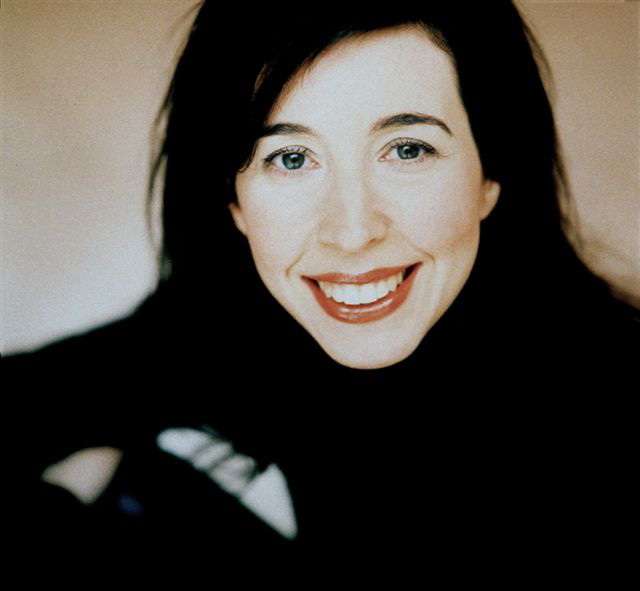|
Back
An Explosion of Colour from Nagano and Messiaen Montréal
Maison symphonique de Montréal, Place des Arts
09/13/2011 - & September 14, 2011
Pyotr Ilyich Tchaikovsky: Meditation in D minor, opus 42, No 1 (excerpt from Memory of a Cherished Place), orchestration by A. Glazunov
Alexander Glazunov: Violin Concerto in A minor, opus 82
Olivier Messiaen: Turangalîla-Symphony
Joshua Bell (Violin), Angela Hewitt (Piano), Jean Laurendeau (Ondes Martenot)
Orchestre symphonique de Montréal, Kent Nagano, Conductor

A. Hewitt (Courtesy of OSM)
On Tuesday evening I attended the first subscription concert of the Orchestre symphonique de Montréal (OSM) in its new home. The concert was also billed as the last of several inaugurating the new Maison symphonique de Montréal. I was seated near the front of the second balcony (one level lower from where I sat for Beethoven’s Ninth on opening night).
Joshua Bell was the guest for the first half of the concert. The program opened with Tchaikovsky’s Meditation in D minor, opus 42, No. 1, arranged by Glazunov. This short work, originally intended as the adagio for Tchaikovsky’s Violin Concerto requires no percussion and little brass (except for two horns). Bell’s performance was gentle and sweet, beautifully supported by the prominent woodwinds and harp.
This was followed by Glazunov’s Concerto for Violin in A minor. Bell’s playing was adequate, except for some dropped notes and thinness of sound. There was depth and resonance in the second movement, but he lacks the heft and authority of an Oistrakh or a Stern. From my seat near the front of the second balcony the sound wasn’t muddy and off-balance as it was for Beethoven’s Ninth last week. It was clear but dry and distant. Although I was sitting about 100 feet from the stage, the sound didn’t rise and grab me. There was little warmth. Because the architects had told us repeatedly that the design of the new hall would allow for an intimate experience and sense of occasion, I was becoming increasingly concerned that I wasn’t getting any of this. A friend sitting in the centre of the main floor found the sound wonderful and agreed to exchange seats with me for the Messiaen in the second half.
This was a revelation. I now had the sense of looking up at an immense orchestra and of being surrounded by 100 musicians in a vast semi-circle. I counted twelve percussionists stretching from one far edge of the stage to the other. Musicians were placed on more and higher risers than in the Salle Wilfred Pelletier. Nagano has a reputation of excelling in the 20th century repertory, and his intimate association with Messiaen and his works more than qualified him to conduct the Turangalîla Symphony. This he did with resounding success. At all times during the performance I could easily hear any instrument of the orchestra I chose. They all played exceptionally well, and with vigour and transparency. Nagano attacked the work with verve, vision and authority. From the opening chaos, to the tectonic shifts in rhythms, the bird calls, the dance of the fifth movement (“Joie du sang des étoiles”) to the joyous finale, Nagano and Messiaen delivered a garden of earthly and cosmic delights. The brass glistened, the percussion supplied nuance and thunder, the strings rendered love songs with passion and delicacy, and the woodwinds frolicked like delirious creatures in the wood.
These performers were joined by Angela Hewitt at the piano and Jean Laurendeau on the ondes Martenot. Better known for her interpretation of the standard repertory and Bach, Hewitt, playing the Turangalîla in public for the first time, threw herself into the part. She rendered each note, chord, trill and arpeggio exquisitely. She smiled, frowned and laughed with delight as she wound her way through this most treacherous of scores, a score without pattern or direction, a score in which every note has to be considered on its own terms. Equally fascinating was Laurendeau on the ondes Martenot, a spinet-like instrument produced in 1928 to produce amplified, oscillating waves of sound one note at a time. Its eerie, haunting sounds lead the listener into another realm of spiritual consciousness.
Why were the acoustics so good from this seat? As one friend asked, had I found a “sweet spot”? Afterwards I heard reports of tininess and brittleness from patrons sitting to the sides of the main floor. And my friend in the second balcony still heard imbalances, mushiness and blaring trumpets, but couldn’t hear the piano except when it was playing alone. Perhaps further adjustments in the positioning of the acoustic baffles and curtains still have to be made. After three concerts I have to say that the jury is still out. I’ll have to hear some Brahms, Bruckner or Mahler to determine whether or not the hall can deliver a warm, enveloping sound.
There are other design issues with the hall. The most pressing is people flow. Only one single-file escalator links the lower lobby to the main floor. Patrons then have to climb stairs to each of the three balconies. There are just two elevators, one on each side of the hall. The side aisles in the auditorium (there are no centre aisles) are too narrow. It took me almost ten minutes to descend a single level after the performance.
Earl Arthur Love
|